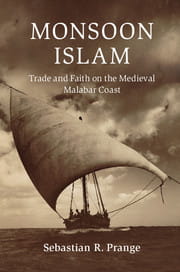
Monsoon Islam: Trade and Faith on the Medieval Malabar Coast
LOUIS WERNER
Sebastian R. Prange
2018, Cambridge UP, 978-1-10842-438-7, $120 hb.
Western scholars of Islam and its myriad civilizations have long qualified the religion by many geographical and cultural subheadings: African Islam, folk Islam, urban Islam, or the like. This is the first academic attempt to analyze Islam through the lens of a weather pattern. Prange looks at India’s Malabar Coast, bilad al-filfil (land of pepper), so named by Arab merchants who arrived on the monsoon trade winds beginning even before the first Islamic century. He argues that Islamic expression there and at the far ends of all its commercial traces on the Indian Ocean littoral is a synthesis explained by the seasonality of these traders’ arrivals and departures, permanent settlements, and their commercial and personal interactions among Hindu and fellow Muslim South Indians. By all readings, Prange’s analysis is a success.
You may also be interested in...

Dissolved Monopoly’s Legacy Hinges on How India Honors Its Political Architecture
From the first fortified trading post in northeastern India, historian Rosie Llewellyn-Jones tracks the physical changes wrought by the English East India Company.
Child's Play: Reconstructing Everyday Life of Youth in Ancient Egypt
Egyptologist Amandine Marshall observes how the depictions of children created by Ancient Egyptians seldom illustrated their actual lives.
Archeologist Breathes New Life Into Recently Abandoned 5,000-Year-Old City
Archeologist Rubina Raja pieces together Palmyra’s life story, from its Bronze Age beginnings to its place as a trading hub for the Roman Empire.